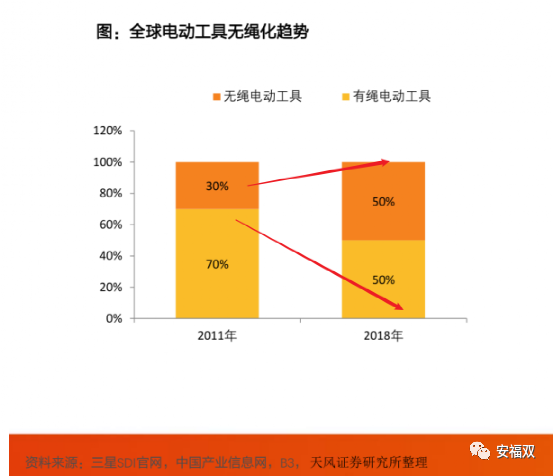Market analysis of power tool lithium battery industry
The lithium battery used in power tools is a cylindrical lithium battery. Batteries for power tools are mainly used for high-rate batteries. According to the application scenario, the battery capacity covers 1Ah-4Ah, of which 1Ah-3Ah is mainly 18650, and 4Ah is mainly 21700. The power requirements range from 10A to 30A, and the continuous discharge cycle is 600 times.
According to Leading Industry Research Institute, the estimated market space in 2020 is 15 billion yuan, and the forward market space is about 22 billion yuan. The mainstream price of a single battery for electric tools is about 11-16 yuan. Assuming an average unit price of 13 yuan per battery, it is estimated that the sales volume in 2020 will be about 1.16 billion, and the market space in 2020 will be about 15 billion yuan, and the compound growth rate is expected to be 10%. The market space in 2024 is about 22 billion yuan.
The penetration rate of cordless power tools currently exceeds 50%. Lithium battery costs account for 20%-30%. Based on this rough calculation, by 2024, the global lithium battery market will reach at least 29.53 billion-44.3 billion yuan.
Combining the above two estimation methods, the market size of lithium batteries for power tools is around 20 to 30 billion. It can be seen that compared to power lithium batteries for electric vehicles, the market space for lithium batteries for electric tools is relatively small.
In 2019, the global output of lithium battery power tools exceeded 240 million units. The former power tool batteries are shipped about 1.1 billion units each year.
The capacity of a single battery cell ranges from 5-9wh, most of which are 7.2wh. It can be estimated that the current installed capacity of power tool batteries is about 8-9Gwh. The Leading Industry Research Institute expects that the installed capacity in 2020 will be close to 10Gwh.
The upstream is positive electrode materials, negative electrode materials, electrolytes, separators, etc. Suppliers include Tianli Lithium Energy, Beterui, etc.
From early January 2021, due to the increase in raw material prices, many cylindrical battery factories such as Tianpeng and Penghui have begun to increase their prices. It can be seen that lithium battery companies have certain cost transfer capabilities.
Downstream are power tool companies, such as: Innovation Technology Industry, Hitachi, Japan’s Panasonic, METABO, Hilti, Ruiqi, Yexing Technology, Nanjing Deshuo, Bosch, Makita, Schneider, Stanley Black & Decker, etc. The competitive landscape of power tools is relatively concentrated. The first echelon is TTI Innovation and Technology Industry, Stanley Black & Decker, and Bosch. In 2018, the market share of the three companies is about 18-19%, and CR3 is about 55%. Power tool products can be divided into professional grade and consumer grade. In the terminal demand of power tools, commercial buildings accounted for 15.94%, industrial buildings accounted for 13.98%, decoration and engineering accounted for 9.02%, and residential buildings accounted for 15.94%. 8.13%, mechanical construction accounted for 3.01%, the five types of demand accounted for a total of 50.08%, and downstream construction-related demand accounted for more than half. It can be seen that construction is the most important terminal application field and source of demand in the power tool market .
In addition, North America is the largest demand region for power tools, accounting for 34% of the global power tool market sales, the European market for 30%, and Europe and the United States for a total of 64%. They are the two most important power tool markets in the world. The European and American markets have the largest market share of power tools in the world because of their higher residential area per capita and the world’s top disposable income per capita. The larger residential area per capita has given more application space for power tools, and it has also stimulated the demand for power tools in the European and American markets. The high level of per capita disposable income means that European and American consumers have strong purchasing power, and they can buy them. With willingness and purchasing power, the European and American markets have become the world’s largest power tool market.
The gross profit margin of power tool lithium battery companies is more than 20%, and the net profit margin is about 10%. They have the typical attributes of heavy asset manufacturing and high fixed assets. Compared with the Internet, liquor, consumption and other industries, making money is more difficult.
Competitive landscape
The main suppliers of power tool batteries are Japanese and Korean companies. In 2018, Samsung SDI, LG Chem, and Murata together accounted for about 75% of the market. Among them, Samsung SDI is the absolute leader, accounting for 45% of the global market share.
Among them, Samsung SDI’s revenue in small lithium batteries is around 6 billion.
According to data from the Advanced Industry Research Institute of Lithium Battery (GGII), domestic power tool lithium battery shipments in 2019 were 5.4GWh, an increase of 54.8% year-on-year. Among them, Tianpeng Power (subsidiary of Blue Lithium Core (SZ:002245)), Yiwei Lithium Energy, and Haisida ranked in the top three.
Other domestic companies include: Penghui Energy, Changhong Energy, Del Neng, Hooneng Co., Ltd., Ousai Energy, Tianhong Lithium Battery,
Shandong Weida (002026), Hanchuan Intelligent, Kane, Far East, Guoxuan Hi-Tech, Lishen Battery, etc.
Key elements of competition
As the concentration of the power tool industry continues to increase, it is very important for power tool lithium battery companies to enter the supply chain of the top few major customers. The requirements of major customers for lithium batteries are: high reliability, low cost, and sufficient production capacity.
Technically speaking, Blue Lithium Core, Yiwei Lithium Energy, Haistar, Penghui Energy, and Changhong Energy can all meet the requirements of major customers, so the key is scale. Only large-scale enterprises can guarantee the production capacity of major customers, continue to amortize costs, obtain higher profits, and then invest in higher research and development to continuously meet the new needs of major customers.
Yiwei’s lithium energy production scale is 900,000 pieces per day, Azure Lithium Core is 800,000, and Changhong Energy is 400,000. The production lines are imported from Japan and South Korea, mainly South Korea.
The automation level of the production line must be high, so that the consistency of product quality is high, in order to enter the supply chain of major customers.
Once the supply relationship is confirmed, changes will not be made easily in the short term, and lithium battery companies entering its supply chain will maintain a stable market share for a certain period of time. Take TTI as an example, its supplier selection needs to go through 230 audits, which lasted nearly 2 years. All new suppliers need to be screened by environmental and social standards and ensure that no major violations are found.
Therefore, domestic power tool lithium battery companies are desperately expanding their production capacity and scale, entering the supply chains of major customers such as Black & Decker and TTI.
Performance drivers
The replacement of electric tools is relatively frequent, and there is a demand for replacement in stock.
The increase in battery life of some electric tools has increased the number of batteries, gradually developing from 3 strings to 6-10 strings.
The penetration rate of cordless power tools continues to increase.
Compared with cordless power tools, cordless power tools have obvious advantages: 1) Flexible and portable. Since cordless power tools have no cables and no need to rely on auxiliary power supplies, cordless tools provide greater flexibility and portability; 2) Safety, when working on multiple projects or in small spaces, cordless tools allow users to move freely without tripping or entangled wires. Especially for companies or contractors who need to walk around the construction site frequently, safety issues are very important; 3) Easy to store, cordless power tools are usually easier to store than wired tools, cordless drills, saws, and impactors can be placed In drawers and shelves, there are usually separate storage containers for storing tools and their attached batteries; 4) The noise is small, the pollution is less, and the working time is longer.
In 2018, the cordless penetration rate of power tools was 38%, and the scale was US$17.1 billion; in 2019, it was 40%, and the scale was US$18.4 billion. With the advancement of battery and motor technology and the decline in costs, the future cordless penetration rate will maintain a rapid upward trend, which will stimulate consumer replacement demand, and the higher average price of cordless power tools will help expand the market.
Compared with the overall power tools, the cordless penetration rate of large-scale electric equipment is still relatively low. In 2019, the cordless penetration rate of large-scale electric equipment was only 13%, and the market size was only 4.366 billion US dollars. Large-scale electric equipment is generally larger and has greater power, and usually has its specific purpose, such as gas-powered high-pressure cleaners, frame inverters, lake deicers, etc. There are two main reasons for the low cordless penetration rate of large-scale electric equipment: 1) Higher requirements for battery output power and energy density, more complex battery systems and stricter safety guarantees, resulting in technical difficulties and technical difficulties for cordless large-scale electric equipment The cost is relatively high; 2) At present, major manufacturers have not regarded cordless large-scale electric equipment as the focus of research and development. However, with the vigorous development of new energy vehicles in recent years, the technology of large-scale power batteries has made great progress, and there is still a lot of room for the cordless penetration rate of large-scale electric equipment in the future.
Domestic substitution: Domestic manufacturers have significant cost advantages. Under the background of no significant differences in technology, domestic substitution has become a trend.
In recent years, domestic Yiwei Lithium Energy and Tianpeng have entered the supply chain of first-line brand suppliers such as TTI and Ba & Decker. The main reasons are 1) At the technical level, domestic head manufacturers have not far from Japan and South Korea’s leading companies, and power tools have special application scenarios. , Leading to the need for fast charging and fast release, so high-rate batteries are required. In the past, Japanese and Korean companies have certain advantages in the accumulation of high-rate batteries. However, as domestic companies have broken through the 20A discharge current bottleneck in recent years, the technical level has been met. In order to meet the basic needs of power tools, power tools have entered the stage of cost competition.
2) The domestic cost is significantly lower than that of overseas manufacturers. The price advantage will help domestic manufacturers continue to seize the share of Japan and South Korea. From the price side, the price range of Tianpeng’s products is 8-13 yuan/piece, while the price band of Samsung SDI is 11. -18 yuan/piece, corresponding to the comparison of products of the same type, the price of Tianpeng is 20% lower than that of Samsung SDI.
In addition to TTI, Black & Decker, Bosch, etc. are currently accelerating the introduction of verification and introduction of cylindrical batteries in China. Based on the accelerating progress of domestic cell factories in the field of high-rate cylindrical cells, and with the comprehensive advantages of performance, scale, and cost, the power tool giant’s choice of cell supply chain has clearly turned to China.
In 2020, due to the impact of the new type of coronavirus pneumonia, Japan and South Korea’s battery production capacity is insufficient, resulting in a shortage of cylindrical li-ion lithium-ion battery market supply, and the domestic return to normal production earlier, the production capacity can make up for the relevant gap, and accelerate the process of domestic substitution.
In addition, the boom of the power tool industry is highly positively correlated with North American housing data. Since the beginning of 2019, the North American real estate market has continued to be hot, and it is expected that North American terminal demand for power tools will remain high in 2021-2022. In addition, after the seasonal adjustment in December 2020, the inventory-to-sales ratio of North American retailers is only 1.28, which is lower than the historical safety inventory of 1.3-1.5, which will open up the demand for replenishment.
The U.S. real estate market is in a boom cycle, which will drive the demand for power tools in the North American market. U.S. housing mortgage interest rates are at a historically low level, and the boom in the U.S. real estate market will continue. Take the 30-year fixed interest rate mortgage loan as an example. In 2020, due to the impact of the new crown epidemic, the Federal Reserve has repeatedly implemented loose monetary policy. The lowest value of the 30-year fixed interest rate mortgage loan hit 2.65%, a record low. It is estimated that the number of newly built private residences in the United States may eventually exceed 2.5 million, a record high.
The end demand and inventory cycle related to real estate resonate upwards, which will strongly drive the demand for power tools, and power tool companies will benefit a lot from this cycle. The growth of power tool companies will also strongly stimulate upstream lithium battery companies.
In summary, the power tool lithium battery is expected to be in a prosperous period in the next three years, and the top domestic ones will benefit from domestic substitution: Yiwei Lithium Energy, Azure Lithium Core, Haistar, Changhong Energy, etc. Yiwei Lithium Energy and other lithium battery businesses such as power batteries also have good prospects. The company has technology and scale advantages, strong strategic forward-looking capabilities, and obvious competitive advantages. Although the lithium battery sector is growing at a high rate, there are also LEDs and metals. Logistics business, the business is relatively complex; Haistar has not yet been listed; Changhong Energy is relatively small in the selected layer of the New Third Board, but it has grown rapidly; in addition to the lithium battery business, more than half are alkaline dry batteries, and the growth is also good. , The probability of IPO transfer in the future is very high.
Post time: Sep-17-2021










